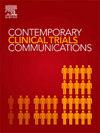Phase 1 clinical trial on Orgasmic Meditation (OM): Assessing safety and feasibility as a meditation practice for individuals with PTSD
IF 1.4
Q4 MEDICINE, RESEARCH & EXPERIMENTAL
引用次数: 0
Abstract
Background
We measured the safety and efficacy of a treatment protocol that includes Orgasmic Meditation (OM), a structured attention training practice conducted between two people who follow a predefined set of detailed instructions. The practice involves one person gently stroking the clitoris of the other person for 15 minutes while both place their attention on the point of contact and notice what they feel. Practitioners of OM have reported that this practice is distinct both from typical sexual engagement and other forms of meditation (Siegel et al., 2022).
Methods
Approved by Advarra Pro00061665. The study involved 28 participants (14 pairs), who were recruited based on residence in the Massachusetts area, being in a relationship, and having no history of practicing OM. Twenty-three of these participants identified and scored as having PTSD symptoms (PCL-5 scores >31). Participants were instructed to perform the OM practice a minimum of 12 times over a 4-week period and met weekly with the principal investigator to determine if any safety issues were manifesting. A series of surveys (Daily: Tumescence Survey and OM journal. Baseline and weekly: PCL-5. Baseline, completion and follow up: Eudaimonia assessment, PHQ-9, Gad-7, BIPF, and OM perception survey at) were administered to measure the results.
Results
Orgasmic Meditation showed positive results in persons with PTSD. Orgasmic meditation is safe and may offer improvement in symptoms. OM showed 47 % improvement in PTSD scores Average score decreased from 60 to 28. Average score across 23 participants rate 4.9/5 that OM is safe.
Conclusion
These results suggest that Orgasmic Meditation may be safe for this traumatized population, and may ameliorate symptoms of PTSD. Further research appears to be warranted to determine the efficacy of OM in treatment of PTSD.
高潮冥想(OM)的第一阶段临床试验:评估作为PTSD患者冥想练习的安全性和可行性
我们测量了一种治疗方案的安全性和有效性,其中包括高潮冥想(OM),这是一种在两个人之间进行的有组织的注意力训练练习,他们遵循一套预定义的详细说明。这个练习包括一个人轻轻地抚摸另一个人的阴蒂15分钟,同时两人都把注意力放在接触点上,注意他们的感觉。OM的实践者报告说,这种练习不同于典型的性接触和其他形式的冥想(Siegel et al., 2022)。方法:Advarra Pro00061665批准。这项研究涉及28名参与者(14对),他们被招募的基础是居住在马萨诸塞州地区,处于恋爱关系中,没有OM的历史。这些参与者中有23人被确定并被评分为患有PTSD症状(PCL-5得分>;31)。参与者被要求在4周的时间内至少进行12次OM练习,并每周与首席研究员会面,以确定是否存在任何安全问题。一系列的调查(每日:肿胀调查和OM杂志)。基线和每周:PCL-5。基线、完成和随访:使用幸福感评估、PHQ-9、Gad-7、BIPF和OM感知调查(at)来衡量结果。结果高潮冥想对PTSD患者有积极效果。性高潮冥想是安全的,可能会改善症状。OM的PTSD评分提高了47%,平均评分从60分下降到28分。23名参与者的平均得分为4.9/5,认为OM是安全的。结论性高潮冥想对创伤人群可能是安全的,并可能改善PTSD的症状。进一步的研究似乎有必要确定OM治疗创伤后应激障碍的疗效。
本文章由计算机程序翻译,如有差异,请以英文原文为准。
求助全文
约1分钟内获得全文
求助全文
来源期刊

Contemporary Clinical Trials Communications
Pharmacology, Toxicology and Pharmaceutics-Pharmacology
CiteScore
2.70
自引率
6.70%
发文量
146
审稿时长
20 weeks
期刊介绍:
Contemporary Clinical Trials Communications is an international peer reviewed open access journal that publishes articles pertaining to all aspects of clinical trials, including, but not limited to, design, conduct, analysis, regulation and ethics. Manuscripts submitted should appeal to a readership drawn from a wide range of disciplines including medicine, life science, pharmaceutical science, biostatistics, epidemiology, computer science, management science, behavioral science, and bioethics. Contemporary Clinical Trials Communications is unique in that it is outside the confines of disease specifications, and it strives to increase the transparency of medical research and reduce publication bias by publishing scientifically valid original research findings irrespective of their perceived importance, significance or impact. Both randomized and non-randomized trials are within the scope of the Journal. Some common topics include trial design rationale and methods, operational methodologies and challenges, and positive and negative trial results. In addition to original research, the Journal also welcomes other types of communications including, but are not limited to, methodology reviews, perspectives and discussions. Through timely dissemination of advances in clinical trials, the goal of Contemporary Clinical Trials Communications is to serve as a platform to enhance the communication and collaboration within the global clinical trials community that ultimately advances this field of research for the benefit of patients.
 求助内容:
求助内容: 应助结果提醒方式:
应助结果提醒方式:


